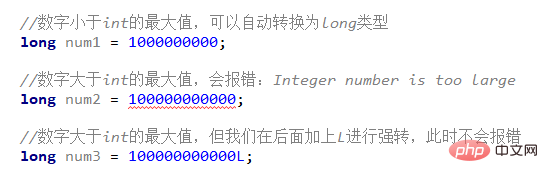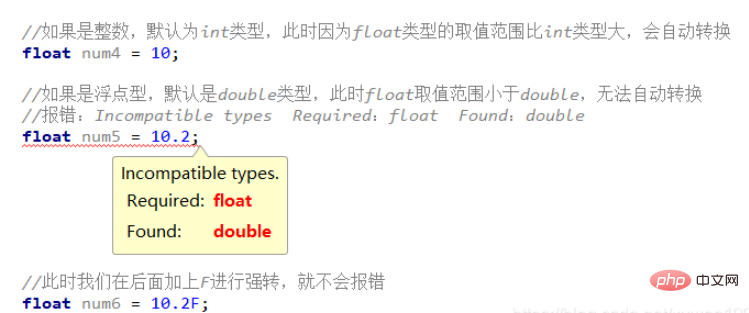How to define Long type in Java
Java defines Long data type
Long lg=10L;
Just add an L after the defined integer type;
It is the same as defining float data type
Float ft=5.20F;
Java definition Why do we need to add L and F to long and float?
Why do we need to add L when defining long type variables?
Basic data type int, occupies 4 bytes, the value range is -231 ~ 231-1, converted to decimal is -2147483648 ~ 2147483647
Basic data type long, occupies 8 bytes, the value range is -263 ~ 263-1, converted to decimal is -9223372036854775808 ~ 9223372036854775807
We know that in In Java, the default data type for integers is int. When we assign an integer to a variable of any type, the integer defaults to type int.
If this number is less than the maximum value of int, you can directly assign a value to long, because the value range of int is smaller than the long type and can be automatically converted.
If this number is greater than the maximum value of int, automatic conversion cannot be performed at this time. We need to add L after the number to perform forced conversion, otherwise an error will be reported.

#Why do you need to add F when defining a float type variable?
-
Basic data typefloat, occupies 4 bytes, the value range is -3.40E 38 ~ 3.40E 38
Basic data typedouble, occupies 8 bytes, the value range is -1.79E 308 ~ 1.79E 308
The default data type of floating point numbers in Java is double. When we assign a floating point number to a variable of any type, the floating point number defaults to double type.
If we assign an integer to float, because the value range of float is greater than int, it will be converted automatically
If we assign a floating point number to float, because the value range of float is smaller than double , then you need to add F at the end for forced transfer

The above is the detailed content of How to define Long type in Java. For more information, please follow other related articles on the PHP Chinese website!

Hot AI Tools

Undresser.AI Undress
AI-powered app for creating realistic nude photos

AI Clothes Remover
Online AI tool for removing clothes from photos.

Undress AI Tool
Undress images for free

Clothoff.io
AI clothes remover

AI Hentai Generator
Generate AI Hentai for free.

Hot Article

Hot Tools

Notepad++7.3.1
Easy-to-use and free code editor

SublimeText3 Chinese version
Chinese version, very easy to use

Zend Studio 13.0.1
Powerful PHP integrated development environment

Dreamweaver CS6
Visual web development tools

SublimeText3 Mac version
God-level code editing software (SublimeText3)

Hot Topics
 Square Root in Java
Aug 30, 2024 pm 04:26 PM
Square Root in Java
Aug 30, 2024 pm 04:26 PM
Guide to Square Root in Java. Here we discuss how Square Root works in Java with example and its code implementation respectively.
 Perfect Number in Java
Aug 30, 2024 pm 04:28 PM
Perfect Number in Java
Aug 30, 2024 pm 04:28 PM
Guide to Perfect Number in Java. Here we discuss the Definition, How to check Perfect number in Java?, examples with code implementation.
 Random Number Generator in Java
Aug 30, 2024 pm 04:27 PM
Random Number Generator in Java
Aug 30, 2024 pm 04:27 PM
Guide to Random Number Generator in Java. Here we discuss Functions in Java with examples and two different Generators with ther examples.
 Weka in Java
Aug 30, 2024 pm 04:28 PM
Weka in Java
Aug 30, 2024 pm 04:28 PM
Guide to Weka in Java. Here we discuss the Introduction, how to use weka java, the type of platform, and advantages with examples.
 Armstrong Number in Java
Aug 30, 2024 pm 04:26 PM
Armstrong Number in Java
Aug 30, 2024 pm 04:26 PM
Guide to the Armstrong Number in Java. Here we discuss an introduction to Armstrong's number in java along with some of the code.
 Smith Number in Java
Aug 30, 2024 pm 04:28 PM
Smith Number in Java
Aug 30, 2024 pm 04:28 PM
Guide to Smith Number in Java. Here we discuss the Definition, How to check smith number in Java? example with code implementation.
 Java Spring Interview Questions
Aug 30, 2024 pm 04:29 PM
Java Spring Interview Questions
Aug 30, 2024 pm 04:29 PM
In this article, we have kept the most asked Java Spring Interview Questions with their detailed answers. So that you can crack the interview.
 Break or return from Java 8 stream forEach?
Feb 07, 2025 pm 12:09 PM
Break or return from Java 8 stream forEach?
Feb 07, 2025 pm 12:09 PM
Java 8 introduces the Stream API, providing a powerful and expressive way to process data collections. However, a common question when using Stream is: How to break or return from a forEach operation? Traditional loops allow for early interruption or return, but Stream's forEach method does not directly support this method. This article will explain the reasons and explore alternative methods for implementing premature termination in Stream processing systems. Further reading: Java Stream API improvements Understand Stream forEach The forEach method is a terminal operation that performs one operation on each element in the Stream. Its design intention is






